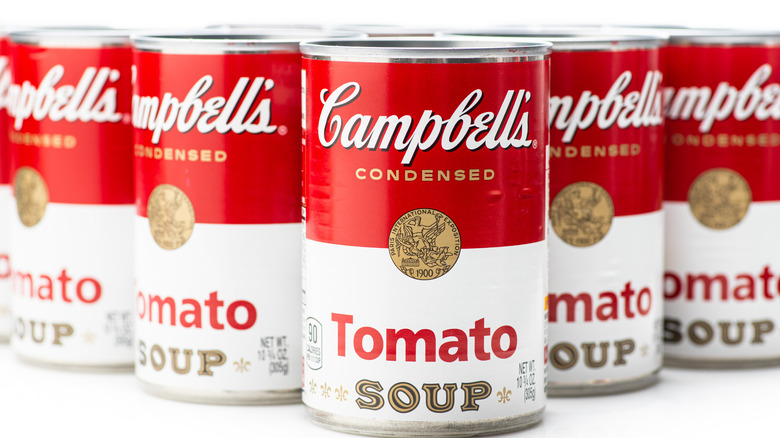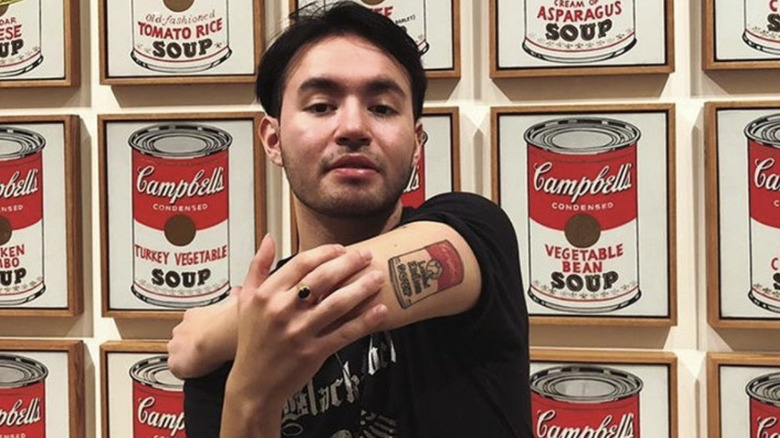A Condensed History Of The Campbell's Tomato Soup Can
It's hard to imagine a world — or at least a grocery store — without Campbell's Tomato Soup. The iconic red and white can has been basking in label-art glory for more than 120 years, preceded by a one-year stint bearing orange hues and the name of "Condensed Beefsteak Tomato Soup."
New Jersey beefsteak tomatoes had been a staple food item for produce vendor Joseph Campbell long before releasing his first ready-for-use soup in 1895. The company's new invention in 1897, condensed soup inside a metal can, changed the way the world approached soup — and even food in general. Soups suddenly became affordable, accessible, and long-lasting due to preservation inside the cans.
The red-and-white color scheme idea came from company executive Herberton L. Williams after he admired the color combination utilized in the football uniforms of Cornell University players. His attendance at a Cornell versus University of Pennsylvania game in 1898 inadvertently created the bold red labeling that has endured through generations of advertisement art.
Eventually, the blazing red label became a symbol of Americana and evolving consumerism, solidified in the 1960s pop-art movement by none other than artist Andy Warhol.
Collaborative design creates everlasting soup label
It's likely the actual design of the original tomato soup label came from an informal collaboration between Campbell's owners and employees. A corporate archivist with the company told The New York Times in 2011 that the design elements included small evolutions, pointing out how the cursive label script resembled the signature of Joseph Campbell himself.
The cursive script also lent credibility to the notion of soup as an everyday comfort food, bringing to mind the handwritten nature of recipes often passed around by housewives of the 1900s. The center medallion on the soup labels replicates a medal awarded to the company at the 1900 Paris Exposition Universelle. The bronze medal recognized product excellence and still adorns all Campbell's soup cans today.
The tomato soup earned legitimacy on its own merits, but it's questionable whether the sustained "icon" status would have taken hold without the elevating attention of America's influential pop-art master.
Warhol and Campbell's impact company history
Though Andy Warhol didn't create the Campbell's soup label, the famous artist certainly elevated it to pop-culture status by appropriating the artwork into a 1962 exhibition titled "Campbell's Soup Cans." Warhol's version of the cans, which had grown from the original tomato soup to 32 condensed soups by the mid-60s, were handpainted on individual canvases and displayed side-by-side in rows to mimic the aisle of a grocery store. A hand-stamped fleur de lys pattern rimmed the bottom of each can.
Some feel that Warhol was questioning the uniformity of product packaging versus originality in the world of art, but the artist himself said that pop art is about liking things — and he claimed (perhaps tongue-in-cheek) to have consumed Campbell's soup every day for 20 years. It was all about elevating the everyday and ordinary to the status of art, according to the Andy Warhol Museum.
A cover illustration for Esquire Magazine in May 1969 depicts Warhol drowning in a can of Campbell's tomato soup, cementing the relationship between art, food, Warhol, and Campbell's — regardless of perspective.



